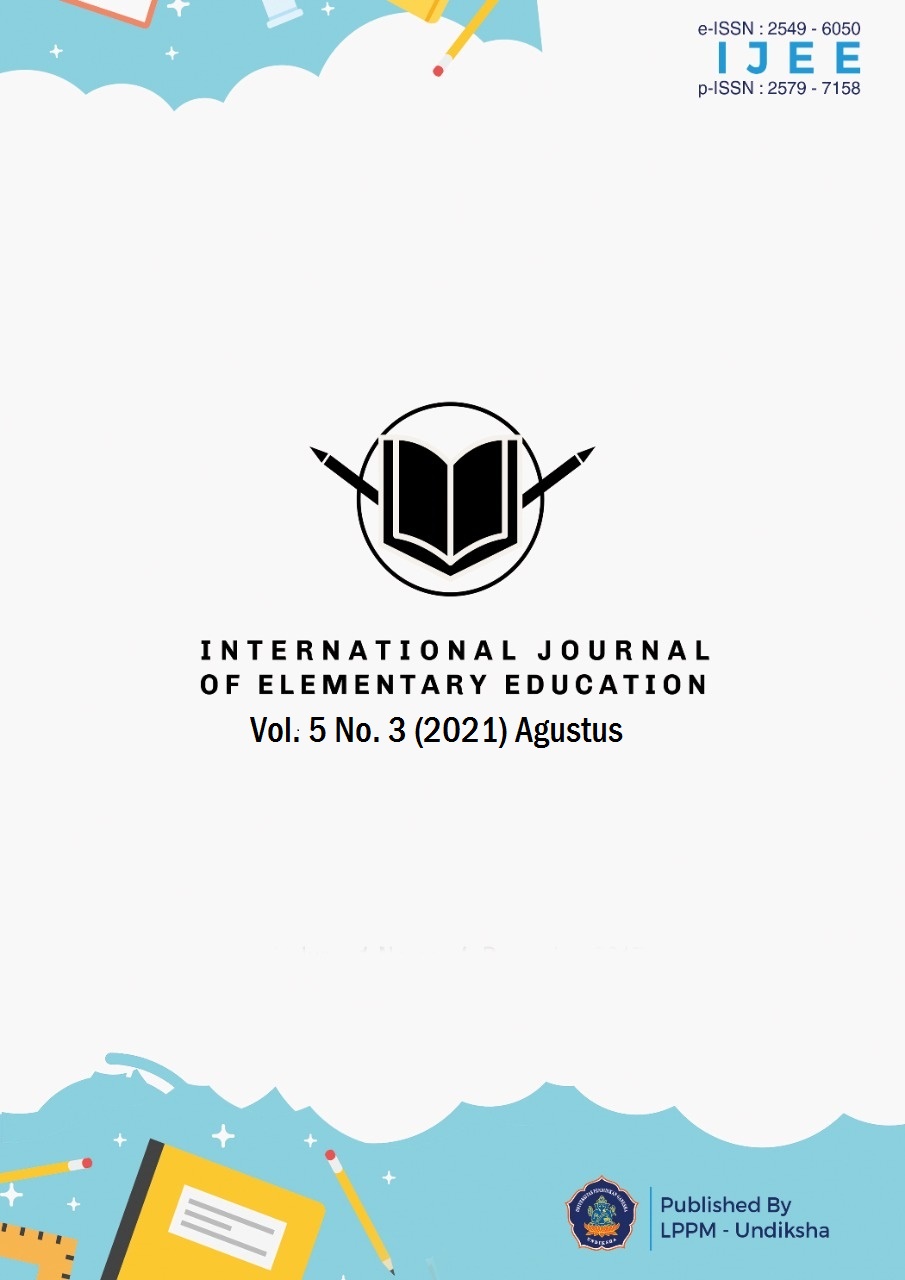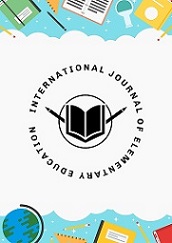Online Learning Innovation: Topic of “Natural and Energy Resources” Using Powtown-Based Learning Video
DOI:
https://doi.org/10.23887/ijee.v5i2.34780Kata Kunci:
Learning Videos, Energy Source, Natural Resource, Model, Powtoon Application, ScienceAbstrak
This research was conducted based on online learning during the pandemic. The use of learning media that is less innovative has an impact on students' interests and understanding. Therefore, it is necessary to develop innovative learning media that can increase students' interest and understanding. This study aims to describe the process of designing learning videos and to find out the results of the acceptance of learning videos on the content of science lessons for grade IV Elementary Schools to determine the acceptance of the products developed. The type of research used is development research, design on video development using the Powtoon application. The data collection method used is the subject questionnaire method in this study is the acceptability of the product which is assessed by 2 lecturers and 2 teachers. The instrument used to measure the acceptability of learning videos is a rating scale in the form of a learning video assessment sheet from an expert. The data obtained were then analyzed using the Gregory formula of 2x2 cross-tabulation to determine the acceptability of the developed learning video. The results of the analysis show that the value obtained from the four experts is 1.00 with a very high product acceptance qualification. Based on this analysis, it can be said that the learning videos developed are valid and can be used in the learning process in the fourth grade of elementary school.
Referensi
Acesta, A. (2014). Penerapan Pendekatan Keterampilan Proses Sains untuk Meningkatkan Hasil Belajar Siswa dalam Pembelajaran IPA. Jurnal Ilmiah Pendidikan Dasar UNISSULA, 1(2), 96764. https://doi.org/10.30659/pendas.1.2.
Aderibigbe, S. A. (2021). Can Online Discussions Facilitate Deep Learning for Students in General Education? Heliyon, 7(3), e06414. https://doi.org/10.1016/j.heliyon.2021.e06414.
Agung, A. A. G. (2014). Metodologi Penelitian Pendidikan. Aditya Media Publishing.
Angrist, N., de Barros, A., Bhula, R., Chakera, S., Cummiskey, C., DeStefano, J., Floretta, J., Kaffenberger, M., Piper, B., & Stern, J. (2021). Building Back Better to Avert a Learning Catastrophe: Estimating Learning Loss from Covid-19 School Shutdowns in Africa and Facilitating Short-Term And Long-Term Learning Recovery. International Journal of Educational Development, 84, 102397. https://doi.org/10.1016/j.ijedudev.2021.102397.
Arulogun, O. T., Akande, O. N., Akindele, A. T., & Badmus, T. A. (2020). Survey Dataset on Open and Distance Learning Students’ Intention to Use Social Media and Emerging Technologies for Online Facilitation. Data in Brief, 31, 105929. https://doi.org/10.1016/j.dib.2020.105929.
Awalia, I., Pamungkas, A. S., & Alamsyah, T. P. (2019). Pengembangan Media Pembelajaran Animasi Powtoon pada Mata Pelajaran Matematika di Kelas IV SD. Kreano, Jurnal Matematika Kreatif-Inovatif, 10(1), 49–56. https://doi.org/10.15294/kreano.v10i1.18534.
Clark, A., Jit, M., Warren-Gash, C., Guthrie, B., Wang, H. H. X., Mercer, S. W., Sanderson, C., McKee, M., Troeger, C., Ong, K. L., Checchi, F., Perel, P., Joseph, S., Gibbs, H. P., Banerjee, A., Eggo, R. M., Nightingale, E. S., O’Reilly, K., Jombart, T., … Jarvis, C. I. (2020). Global, Regional, and National Estimates of the Population at Increased Risk of Severe Covid-19 Due to Underlying Health Conditions in 2020: A Modelling Study. The Lancet Global Health, 8(8), e1003–e1017. https://doi.org/10.1016/S2214-109X(20)30264-3.
Darmadi, H. (2011). Metode penelitian pendidikan. Bandung: alfabeta.
Handarini, O. I., & Wulandari, S. S. (2020). Pembelajaran Daring Sebagai Upaya Study from Home (SFH) selama Pandemi Covid-19. Jurnal Pendidikan Administrasi Perkantoran (JPAP), 8(1), 496–503.
Hong, K., Uh, Y., & Byun, H. (2021). ArrowGAN : Learning to Generate Videos by Learning Arrow of Time. Neurocomputing, 438, 223–234. https://doi.org/10.1016/j.neucom.2021.01.043.
Hussein, E., Daoud, S., Alrabaiah, H., & Badawi, R. (2020). Exploring Undergraduate Students’ Attitudes towards Emergency Online Learning during Covid-19: A Case From The UAE. Children and Youth Services Review, 119, 105699. https://doi.org/10.1016/j.childyouth.2020.105699.
Khan, M. A., Vivek, Nabi, M. K., Khojah, M., & Tahir, M. (2021). Students’ Perception towards E-Learning during Covid-19 Pandemic in India: An Empirical Study. Sustainability (Switzerland), 13(1), 1–14. https://doi.org/10.3390/su13010057.
Kusumayuni, P. N. (2021). Pengembangan E-Book Berorientasi Ilmiah pada Pelajaran IPA Sekolah Dasar Kelas V. http://dx.doi.org/10.23887/jisd.v5i1.32048.
Liu, C.-H., & You-Hsien Lin, H. (2021). The Impact of Covid-19 on Medical Education: Experiences from One Medical University in Taiwan. Journal of the Formosan Medical Association. https://doi.org/10.1016/j.jfma.2021.02.016.
Nadiyah, R. S., & Faaizah, S. (2015). The Development of Online Project Based Collaborative Learning Using ADDIE Model. Procedia - Social and Behavioral Sciences, 195, 1803–1812. https://doi.org/10.1016/j.sbspro.2015.06.392.
Neukirchen, D., Engelhardt, N., Krause, M., & Posch, P. N. (2021). Firm Efficiency and Stock Returns during the Covid-19 Crisis. Finance Research Letters, 102037. https://doi.org/10.1016/j.frl.2021.102037.
Nurdiansyah, E., Faisal, E. El, & Sulkipani, S. (2018). Pengembangan Media Pembelajaran Berbasis Powtoon pada Perkuliahan Pendidikan Kewarganegaraan. Jurnal Civics: Media Kajian Kewarganegaraan, 15(1), 1–8. https://doi.org/10.21831/jc.v15i1.16875.
Ozdilek, Z., & Robeck, E. (2009). Operational Priorities of Instructional Designers Analyzed within the Steps of the ADDIE Instructional Design Model. Procedia - Social and Behavioral Sciences, 1(1), 2046–2050. https://doi.org/10.1016/j.sbspro.2009.01.359.
Parta, K. Y., & Wati, L. P. S. (2016). Pengaruh Model dan Media Pembelajaran terhadap Hasil Belajar Kemampuan Dasar Senam Lantai pada Mahasiswa Jurusan Penjaskesrek Undiksha. JPI (Jurnal Pendidikan Indonesia), 5(1), 97. https://doi.org/10.23887/jpi-undiksha.v5i1.8932.
Pravitasari, S. G., & Yulianto, M. L. (2018). Penggunaan Multimedia Interaktif dalam Pembelajaran Bahasa Inggris (Studi Kasus di SDN 3 Tarubasan Klaten). Profesi Pendidikan Dasar, 1(1), 37. https://doi.org/10.23917/ppd.v1i1.3825.
Purwanti, B. (2015). Pengembangan Media Video Pembelajaran Matematika dengan Model Assure. Jurnal Kebijakan dan Pengembangan Pendidikan, 3(1), 42–47. https://doi.org/10.22219/jkpp.v3i1.2194.
Putri, R. M., Risdianto, E., & Rohadi, N. (2019). Pengembangan Media Pembelajaran Interaktif dengan Menggunakan Adobe Captivate pada Materi Gerak Harmonik Sederhana. Jurnal Kumparan Fisika, 2(2), 113–120. https://doi.org/10.33369/jkf.2.2.113-120.
Qurrotaini, L., Sari, T. W., & Sundi, V. H. (2020). Efektivitas Penggunaan Media Video Berbasis Powtoon dalam Pembelajaran Daring. Prosiding Seminar Nasional Penelitian LPPM UMJ, E-ISSN: 27, 7.
Rafique, G. M., Mahmood, K., Warraich, N. F., & Rehman, S. U. (2021). Readiness for Online Learning during Covid-19 pandemic: A survey of Pakistani LIS students. The Journal of Academic Librarianship, 47(3), 102346. https://doi.org/10.1016/j.acalib.2021.102346.
Rahmawati, A. S., & Dewi, R. P. (2019). Penggunaan Multimedia Interaktif (MMI) sebagai Media Pembelajaran dalam Meningkatkan Prestasi Belajar Fisika. Jurnal Pendidikan Fisika dan Teknologi, 5(1), 50. https://doi.org/10.29303/jpft.v5i1.958.
Sabates, R., Carter, E., & Stern, J. M. B. (2021). Using Educational Transitions to Estimate Learning Loss Due to Covid-19 School Closures: The Case of Complementary Basic Education in Ghana. International Journal of Educational Development, 82, 102377. https://doi.org/10.1016/j.ijedudev.2021.102377.
Salim dan Haidir. (2019). Penelitian Pendidikan: Metode, Pendekatan, dan Jenis (M. . Ad, Ihsan Satrya Azhar (ed.)).
Sato, S., Kang, T.-A., Daigo, E., Matsuoka, H., & Harada, M. (2021). Graduate Employability and Higher Education’s Contributions to Human Resource Development in Sport Business Before and After Covid-19. Journal of Hospitality, Leisure, Sport & Tourism Education, 28, 100306. https://doi.org/10.1016/j.jhlste.2021.100306.
Seo, K., Dodson, S., Harandi, N. M., Roberson, N., Fels, S., & Roll, I. (2021). Active Learning with Online Video: The Impact ff Learning Context on Engagement. Computers & Education, 165, 104132. https://doi.org/10.1016/j.compedu.2021.104132.
Sholihin, M., Sari, R. C., Yuniartic, N., & Sariyatul, ilyanaa. (2020). A New Way of Teaching Business Ethics: The Evaluation of Virtual Reality-Based Learning Media. The International Journal of Management Education, 18(3), 100428. https://doi.org/10.1016/j.ijme.2020.100428.
Sutama, G. A., Suranata, K., & Dharsana, K. (2014). Penerapan Teori Behavioral dengan Teknik Modeling untuk Meningkatkan Kemandirian Belajar Siswa Kelas AK C SMK Negeri 1 Singaraja. E-Journal Undiksa Jurusan Bimbingan Konseling, 2(1), 1–11.
Tarchi, C., Zaccoletti, S., & Mason, L. (2021). Learning from Text, Video, or Subtitles: A Comparative Analysis. Computers & Education, 160, 104034. https://doi.org/10.1016/j.compedu.2020.104034.
Tegeh, I. M., Jampel, I. N., & Pudjawan, K. (2014). Model Penelitian Pengembangan. Universitas Pendidikan Ganesha.
Toh, W., & Kirschner, D. (2020). Self-Directed Learning in Video Games, Affordances and Pedagogical Implications for Teaching and Learning. Computers & Education, 154, 103912. https://doi.org/10.1016/j.compedu.2020.103912.
Wahyu, Y., Edu, A. L., & Nardi, M. (2020). Problematika Pemanfaatan Media Pembelajaran IPA di Sekolah Dasar. Jurnal Penelitian Pendidikan IPA, 6(1), 107. https://doi.org/10.29303/jppipa.v6i1.344.
Yoon, M., Lee, J., & Jo, I.-H. (2021). Video Learning Analytics: Investigating Behavioral Patterns and Learner Clusters in Video-Based Online Learning. The Internet and Higher Education, 50, 100806. https://doi.org/10.1016/j.iheduc.2021.100806.
Unduhan
Diterbitkan
Cara Mengutip
Terbitan
Bagian
Lisensi
Hak Cipta (c) 2021 International Journal of Elementary Education

Artikel ini berlisensiCreative Commons Attribution-ShareAlike 4.0 International License.
Authors who publish with the International Journal of Elementary Education agree to the following terms:
- Authors retain copyright and grant the journal the right of first publication with the work simultaneously licensed under a Creative Commons Attribution License (CC BY-SA 4.0) that allows others to share the work with an acknowledgment of the work's authorship and initial publication in this journal.
- Authors are able to enter into separate, additional contractual arrangements for the non-exclusive distribution of the journal's published version of the work (e.g., post it to an institutional repository or publish it in a book), with an acknowledgment of its initial publication in this journal.
- Authors are permitted and encouraged to post their work online (e.g., in institutional repositories or on their website) prior to and during the submission process, as it can lead to productive exchanges, as well as earlier and greater citation of published work. (See The Effect of Open Access)










